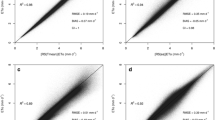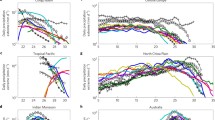Abstract
The signal of recent global warming has been detected in meteorological records, borehole temperatures and by several indirect climate indicators. Anthropogenic warming continues to evolve, and various methods are used to study and predict the changes of the global and regional climate. Results derived from GCMs, palaeoclimate reconstructions, and regional climate models differ in detail. An empirical model could be used to predict the spatial pattern of the near-surface air temperature and to narrow the range of regional uncertainties. The idea behind this approach is to study the correlations between regional and global temperature using century-scale meteorological records, and to evaluate the regional pattern of the future climate using regression analysis and the global-mean air temperature as a predictor. This empirical model, however, is only applicable to those parts of the world where regional near-surface air temperature reacts linearly to changes of the global thermal regime. This method and data from a set of approximately 2000 weather stations with continuous century-scale records of the monthly air temperature was applied to develop the empirical map of the regional climate sensitivity. Data analysis indicated that an empirical model could be applied to several large regions of the World, where correlations between local and global air temperature are statistically significant. These regions are the western United States, southern Canada, Alaska, Siberia, south-eastern Asia, southern Africa and Australia, where the correlation coefficient is typically above 0.9. The map of regional climate sensitivity has been constructed using calculated coefficients of linear regression between the global-mean and regional annual air temperature. As long as the correlations between the local and global air temperature are close to those in the last several decades, this map provides an effective tool to scale down the projection of the global air temperature to regional level. According to the results of this study, maximum warming at the beginning of the 21st century will take place in the continental parts of North America and Eurasia. The empirical regional climate sensitivity defined here as the response of the mean-annual regional temperature to 1 °C global warming was found to be 5–6 °C in southern Alaska, central Canada, and over the continental Siberia, 3–4 °C on the North Slope of Alaska and western coast of the U.S.A., and 1–2 °C in most of the central and eastern U.S.A. and eastern Canada. Regions with negative sensitivity are located in the southeastern U.S.A., north-western Europe and Scandinavia. The local tendency towards cooling, although statistically confirmed by modern data, could, however, change in the near future.
Similar content being viewed by others
REFERENCES
Andre, J. C. and Royer, L. F.: 1999, 'Short-Term Climatic Fluctuations and the Interpretation of Recent Observations in Terms of Greenhouse Effect', C.R. Acad. Sci. II A 328, 261–272.
Arrhenius, S.: 1896, 'On the Influence of the Carbonic Acid in the Air upon the Temperature of Ground', Philos. Mag. 4, 237–275.
Arrhenius, S.: 1907, Das Werden der Welten, Akademische Verlagsgesellschaft, Leipzig, p. 208.
Barnett, T. P., Hasselmann, K., Chelliah, M., Delworth, T., Hegerl, G., Jones, P., Rasmusson, E., Roeckner, E., Ropelewski, C., Santer, B., and Tett, S.: 1999, 'Detection and Attribution of Recent Climate Change: A Status Report', Bull. Amer. Meteorol. Soc. 80, 2631–2659.
Barnett, T. P., Hegerl, G., Knudson, T., and Tett, S.: 2000, 'Uncertainty Levels in Predicted Patterns of Anthropogenic Climate Change', J. Geophys. Res. 105, 15525–15542.
Barnett, T. P., Hegerl, G. C., Santer, B., and Taylor, K.: 1998, 'The Potential Effect of GCM Uncertainties and Internal Atmospheric Variability on Anthropogenic Signal Detection', J. Climate 11, 659–675.
Bjorgo, E., Johannessen, O. M., and Miles, M. W.: 1997, 'Analysis of Merged SMMR-SSMI Time Series of Arctic and Antarctic Sea Ice Parameters 1978–1995', Geophys. Res. Lett. 24, 413–416.
Budyko, M. I. and Izrael, Y. A. (eds.): 1987, Anthropogenic Climatic Change, Hydrometeoizdat, Leningrad, p. 405.
Duchkov, A. D. and Devyatkin, V. N.: 1992, 'Reduced Geothermal Gradients in the Shallow West-Siberian Platform', Global Planet. Change 6, 245–250.
Gates, W. L., Henderson-Sellers, A., Boer, G. J., Folland, C. K., Kiton, A., McAvaney, B. J., Semazzi, F., Smith, N., Weaver, A. J., and Zeng, Q.-C.: 1996, 'ClimateModels – Evaluation', in Houghton, J. T. et al. (eds.), Climate Change 1995: The Science of Climate Change. Contribution of Working Group I to the Second Assessment Report of the Intergovernmental Panel on Climate Change, Cambridge University Press, Cambridge, U.K., pp. 229–284.
Goody, R., Anderson, J., and North, G.: 1998, 'Testing Climate Models: An Approach', Bull. Amer. Meteorol. Soc. 79, 2541–2549.
Gosnold W. D., Todhunter, P. E., and Schmidt, W.: 1997, 'The Borehole Temperature Record of Climate Warming in the Mid-Continent of North America', Global Planet. Change 15, 33–45.
Greco, S., Moss, R. H., Viner, D., and Jenne, R.: 1994, Climate Scenarios and Socioeconomic Projections for IPCC WG II Assessment, Consortium for International Earth Science Information Network, Washington, D.C., p. 11.
Hansen, J., Lacis, A., Ring, D., Russell, G., Stone, P., Fung, I., Ruedy, R., and Lerner, J.: 1984, 'Climate Sensitivity: Analysis of Feedbacks Mechanisms', in Climate Processes and Climate Sensitivity, Geophys. Monograph 29, 130–163.
Hegerl, G. C., Hasselmann, K., Cubasch, U., Mitchell, J. F. B., Roeckner, E., Voss, R., and Waszkewitz, J.: 1997, 'Multi-Fingerprint Detection and Attribution Analysis of Greenhouse Gas, Greenhouse Gas-Plus-Aerosol and Solar Forced Climate Change', Clim. Dyn. 13, 613–634.
Hegerl, G. C., von Storch, H., Hasselmann, K., Santer, B. D., Cubasch, U., and Jones, P. D.: 1996, 'Detecting Greenhouse-Gas-Induced Climate Change with an Optimal Fingerprint Method', J. Climate 9, 2281–2306.
Hewitson, B. C. and Crane, R. G.: 1996, 'Climate Downscaling: Techniques and Application', Clim. Res. 7, 85–95.
Houghton, J., Meira, L., Griggs, D., and Maskell, K. (eds.): 1997, An Introduction to Simple Climate Models Used in the IPCC Second Assessment Report, IPCC Technical Paper II, p. 47.
Houghton, J. T., Meira Filno, L. G., Callander, B. A., Harris, N., Kattenberg, A., and Maskell, K. (eds.): 1996, Climate Change 1995: The Science of Climate Change, Contribution of Working Group I to the Second Assessment Report of the Intergovernmental Panel on Climate Change, Cambridge University Press, Cambridge, U.K., p. 572.
Kattenberg, A., Giorgi, F., Grassl, H., Meehl, G. A., Mitchell, J. F. B., Stouffer, R. J., Tokioka, T., Weaver, A. J., and Wigley, T. M. L.: 1996, 'Climate Models – Projections of Future Climate', in Houghton, J. T. et al. (eds.), Climate Change 1995: The Science of Climate Change, Contribution of Working Group I to the Second Assessment Report of the Intergovernmental Panel on Climate Change, Cambridge University Press, Cambridge, U.K., pp. 285–358.
Lachenbruch, A. H. and Marshall, B. V.: 1986, 'Changing Climate: Geothermal Evidence from Permafrost in the Alaskan Arctic', Science 234, 689–696.
Levine, R. A. and Berliner, L. M.: 1999, 'Statistical Principles for Climate Change Studies', J. Climate 12, 564–574.
Lynch, A. H., Chapman, W. L., Walsh, J. E., and Weller, G.: 1995, 'Development of a Regional Climate Model of the Western Arctic', J. Climate 8, 1555–1570.
MacCracken, M. C., Hecht, A. D., Budyko, M. I., and Izrael, Y. A. (eds.): 1990, Prospects for Future Climate: A Special U.S./U.S.S.R. Report on Climate and Climate Change, Lewis, Chelsea, MI, p. 270.
Manabe, S. and Wetherald, R. T.: 1980, 'On the Distribution of Climate Change Resulting from an Increase in CO2 Content of the Atmosphere', J. Atmos. Sci. 37, 99–118.
Maslanik, J. A., Serreze, M. C., and Barry, R. G.: 1996, 'Recent Decreases in Arctic Summer Ice Cover and Linkages to Atmospheric Circulation Anomalies', Geophys. Res. Lett. 23, 1677–1680.
Mitchell, J. F. B.: 1990, 'Greenhouse Warming – Is the Midholocene a Good Analog', J. Climate 3, 1177–1192.
Mitchell, J. F. B. and Johns, T. C.: 1997, 'On Modification of Global Warming by Sulfate Aerosols', J. Climate 10, 245–267.
Nicholls, N., Gruza, G. V., Jouzel, J., Karl, T. R., Ogallo, L. A., and Parker, D. E.: 1996, 'Observed Climate Variability and Change', in Houghton, J. T. et al. (eds.), Climate Change 1995: The Science of Climate Change, Cambridge University Press, Cambridge, U.K., pp. 133–192.
North, G. R. and Stevens, M. J.: 1998, 'Detecting Climate Signals in the Surface Temperature Record', J. Climate 11, 563–577.
Peterson, T. C. and Vose, R. S.: 1997, 'An Overview of the Global Historical Climatology Network Temperature Database', Bull. Amer. Meteorol. Soc. 78, 2837–2849.
Russell, G. L., Miller, J. R., Rind, D., Ruedy, R. A., Schmidt, G. A., and Sheth, S.: 2000, 'Comparison of Model and Observed Regional Temperature Changes during the Past 40 Years', J. Geophys. Res. Atmos. 105, 14891–14898.
Santer, B. D., Taylor, K. E., Wigley, T. M. L., Penner, J. E., Jones, P. D., and Cubasch, U.: 1995, 'Towards the Detection and Attribution of an Anthropogenic Effect on Climate', Clim. Dyn. 12, 77–100.
Shabalova, M. V. and Konnen, G. P.: 1995, 'Climate-Change Scenarios – Comparisons of Paleoreconstructions with Recent Temperature-Changes', Clim. Change 29, 409–428.
Shackley, S., Young, P., Parkinson, S., and Wynne, B.: 1998, 'Uncertainty, Complexity and Concepts of Good Science in Climate Change Modelling: Are GCMs the Best Tools?', Clim. Change 38, 159–205.
Smith, D. M.: 1998, 'Recent Increase in the Length of the Melt Season of Perennial Arctic Sea Ice', Geophys. Res. Lett. 25, 655–658.
Storch, H., Zorita, E., and Cubasch, U.: 1993, 'Downscaling of Global Climate Change Estimates to Regional Scales: An Application to Iberian Rainfall in Wintertime', J. Climate 6, 1162–1171.
Stott, P. A. and Tett, S. F. B.: 1998, 'Scale-Dependent Detection of Climate Change', J. Climate 11, 3282–3294.
Thompson, L. G., Mosleythompson, E., Davis, M., Lin, P. N., Yao, T., Dyurgerov, M., and Dai, J.: 1993, 'Recent Warming – Ice Core Evidence from Tropical Ice Cores with Emphasis on Central-Asia', Global Planet. Change 7, 145–156.
Vettoretti, G., Peltier, W. R., and McFarlane, N. A.: 1998, 'Simulations of Mid-Holocene Climate Using an Atmospheric General Circulation Model', J. Climate 11, 2607–2627.
Viner, D. and Hulme, M.: 1997, The Climate Impacts LINK Project, University of East Anglia, Norwich, U.K., p. 17.
Vinnikov, K. Y.: 1986, Climate Sensitivity, Hydrometeoizdat, Leningrad, p. 224.
Wigley, T. M. L. and Jones, P. D.: 1981, 'Detecting CO2-Induced Climatic Change', Nature 292, 205–208.
Wigley, T. M. L., Jaumann, P. J., Santer, B. D., and Taylor, K. E.: 1998, 'Relative Detectability of Greenhouse-Gas and Aerosol Climate Change Signals', Clim. Dyn. 14, 781–790.
Wilby, R. L.: 1997, 'Non-Stationarity in Daily Precipitation Series: Implications for GCM Down-Scaling Using Atmospheric Circulation Indices', Int. J. Clim. 17, 439–454.
Wilby, R. L. and Wigley, T. M. L.: 1997, 'Downscaling General CirculationModel Output: A Review of Methods and Limitations', Prog. Phys. Geog. 21, 530–548.
Author information
Authors and Affiliations
Rights and permissions
About this article
Cite this article
Anisimov, O.A. Predicting Patterns of Near-Surface Air Temperature Using Empirical Data. Climatic Change 50, 297–315 (2001). https://doi.org/10.1023/A:1010658014439
Issue Date:
DOI: https://doi.org/10.1023/A:1010658014439




